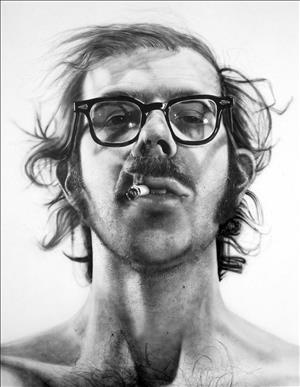On April 17, 1970, American painter Charles "Chuck" Close (1940-2021) exhibits his breakthrough painting Big Self-Portrait (1967-1968) publicly for the first time. The huge self-portrait, a painted enlargement of a close-up photo of the artist's face, is part of an exhibition titled Three Young Americans that opens that day at the Allen Memorial Art Museum at Oberlin College in Ohio. The exhibition, which runs through May 12, 1970, features the work of artists Neil Jenney (b. 1945) and Ron Cooper (b. 1943) in addition to Close. This first public display of Big Self-Portrait comes not long after the work's purchase by the Walker Art Center in Minneapolis. The painting is both the first self-portrait of the artist's career (many will follow) and his first artwork sold to an arts institution.
A New Approach
Born in Monroe, Snohomish County, Chuck Close grew up in Everett and Tacoma, where he practiced drawing and painting from a young age. Close studied art at Everett Junior College and then the University of Washington, from which he graduated in 1962, before moving on to further study at Yale University and then in Vienna.
While influenced by the Abstract Expressionist movement underway during the years of his formal education as a painter in the early 1960s, Close began experimenting in 1967 with a new approach to combining abstraction and realism. He took a series of black-and-white photographs, then used a grid placed over one of these images to paint, grid section by grid section, the image on an enlarged scale. The first such painting, Big Self-Portrait, stands nearly nine feet tall and shows the artist's head and shoulders rendered in minute detail: a cigarette jutting from the right corner of the mouth, the musculature of the neck where it meets the bare shoulders, the hair framing the face in a tangle. In 1969, painting was purchased by the Walker Art Center at a cost of $1,300 for its permanent collection. Martin Friedman (b. 1925), an early advocate of Close who was director of the Walker from 1961 until 1990, recalled that "the price was right" and that it remained a point of friendly rivalry between the two men over the years (Friedman, 11).
Motivations and Techniques
Close offered a new way of looking at portraits through this approach, noting "people think that if you have a photographic image, there is pretty much only one thing you can do with it, that because of its iconography, it is fixed ... but changing the medium, the method of mark-making, and the scale transforms the experience of that image into something new" ("Tacoma Art Museum Presents ...").
Not only was Big Self-Portrait a milestone for Chuck Close in its adoption of the portrait as a consistent, principal theme in his work, but it was also significant as the first artwork he achieved using a new approach to painting technique, with non-traditional tools, such as an airbrush, a razor blade, and an eraser on a power drill. The process was one of conservation and reduction, where paint was thinned down, scraped, erased, and reapplied sparingly. One tube of black paint alone was used to produce seven more portrait paintings.
Close explained this was a conscious choice he made in 1967, and that he was convinced that doing so would help propel him in a new and positive direction as an artist: "If you impose a limit to not do something you've done before, it will push you to where you've never gone before" (Norman).
Many Portraits Follow
In the decades that followed Big Self-Portrait, Chuck Close continued to paint both self-portraits (31 according to the Artifex Press catalogue raisonné) and portraits of many others, even following a debilitating stroke in 1988 that left him partially paralyzed. His subjects ranged from friends and acquaintances to fellow artists, poets, performers, actors, and musicians. Notable as well are several collaborations with others -- such as a series of portraits paired with poems by Bob Holman (b. 1948) featured in 2008 at the Tacoma Art Museum -- which served to continue the artist's vision of the portrait as an expressive subject both on the individual level and through a growing body of his work. While continuing to focus on the human face as inspiration, Close adapted different technical styles and media to his liking, producing work ranging from daguerreotypes and tapestries to digital pigment prints, finger paintings, collages, and acrylics on canvas. In the 45 years since his first self-portrait went on public exhibition in 1970, Close participated in almost 800 group exhibitions.
In 1997 Close was honored by the University of Washington's College of Fine Arts as Alumnus Summa Laude Dignatus. The artist had come far since earning his bachelor of arts degree from the university in 1962, with specific mention made in the 1997 commencement program of his achievements in portraiture: "these portraits, whose subjects seem to dissolve and reform as the viewer moves nearer or farther away, hang in museums and private collections around the world, including the National Gallery in Washington, DC and the Tate Gallery in London" (Program of Exercises, 11). In the same year, another self-portrait done in oil on canvas showed the artist in three-quarter profile view, with this version destined for the Museum of Modern Art's collection in New York.
About his portraits and art in general, Close expounded on his earlier motivations which had their genesis in his first self-portrait: "'Why make art? Because I think there's a child's voice in every artist saying, I am here. I am somebody. I made this. Won't you look?'" (Kimmelman). In 1967, the year he took the first series of photos for his self-portrait, Close moved to New York, where as of 2015 he continued to work out of his studio.

